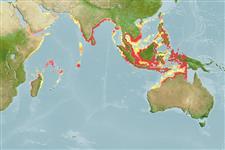>
Clupeiformes (Herrings) >
Dorosomatidae (Gizzard shads and sardinellas)
Etymology: Sardinella: Latin and Greek, sarda = sardine; name related to the island of Sardinia; diminutive (Ref. 45335).
More on author: Bleeker.
Environment: milieu / climate zone / depth range / distribution range
Ecologia
marinhas; intervalo de profundidade 0 - 50 m (Ref. 188). Tropical; 25°N - 23°S, 41°E - 137°E (Ref. 188)
Indo-West Pacific: Madagascar (but apparently not elsewhere in the western Indian Ocean), Madras, Indonesia, northern Australia. Chan's Hong Kong and Taipei specimens were most likely Sardinella hualiensis. Occurrence in Thailand (Ref. 1632) needs to be confirmed.
Tamanho / Peso / Idade
Maturity: Lm ? range ? - ? cm
Max length : 13.0 cm SL macho/indeterminado; (Ref. 188); common length : 12.0 cm SL macho/indeterminado; (Ref. 188)
Espinhos dorsais (total) : 0; Raios dorsais moles (total) : 13 - 21; Espinhos anais: 0; Raios anais moles: 12 - 23. Body deep; total scutes 29 to 32. Vertical striae on scales overlapping or sometimes continuous at center of scale, numerous small perforations on hind part of scale. Closely resembles S. hualiensis which has dark dorsal and caudal fin tips. Differs from other deep-bodied species chiefly in its lower gill raker count and presence of a dark spot at dorsal fin of origin.
Forms schools in coastal waters (Ref. 188, 75154).
Life cycle and mating behavior
Maturidade | Reprodução | Desova | Ovos | Fecundidade | Larvas
Whitehead, P.J.P., 1985. FAO Species Catalogue. Vol. 7. Clupeoid fishes of the world (suborder Clupeoidei). An annotated and illustrated catalogue of the herrings, sardines, pilchards, sprats, shads, anchovies and wolf-herrings. FAO Fish. Synop. 125(7/1):1-303. Rome: FAO. (Ref. 188)
Categoria na Lista Vermelha da IUCN (Ref. 130435: Version 2024-1)
Ameaça para o homem
Harmless
Utilização humana
Pescarias: pouco comercial
Ferramentas
Relatórios especiais
Descarregue XML
Fontes da internet
Estimates based on models
Preferred temperature (Ref.
123201): 27.6 - 29.2, mean 28.6 °C (based on 786 cells).
Phylogenetic diversity index (Ref.
82804): PD
50 = 0.5000 [Uniqueness, from 0.5 = low to 2.0 = high].
Bayesian length-weight: a=0.00813 (0.00495 - 0.01335), b=3.09 (2.95 - 3.23), in cm total length, based on LWR estimates for this species & Genus-body shape (Ref.
93245).
Nível Trófico (Ref.
69278): 2.9 ±0.3 se; based on size and trophs of closest relatives
Resiliência (Ref.
120179): Elevada, tempo mínimo de duplicação da população menor que 15 meses (Preliminary K or Fecundity.).
Fishing Vulnerability (Ref.
59153): Low vulnerability (10 of 100).
Nutrients (Ref.
124155): Calcium = 338 [184, 527] mg/100g; Iron = 2.11 [1.25, 3.75] mg/100g; Protein = 20.4 [19.5, 21.4] %; Omega3 = 0.312 [0.152, 0.614] g/100g; Selenium = 82.9 [43.0, 161.6] μg/100g; VitaminA = 36.7 [11.6, 111.0] μg/100g; Zinc = 1.4 [1.0, 1.9] mg/100g (wet weight);
